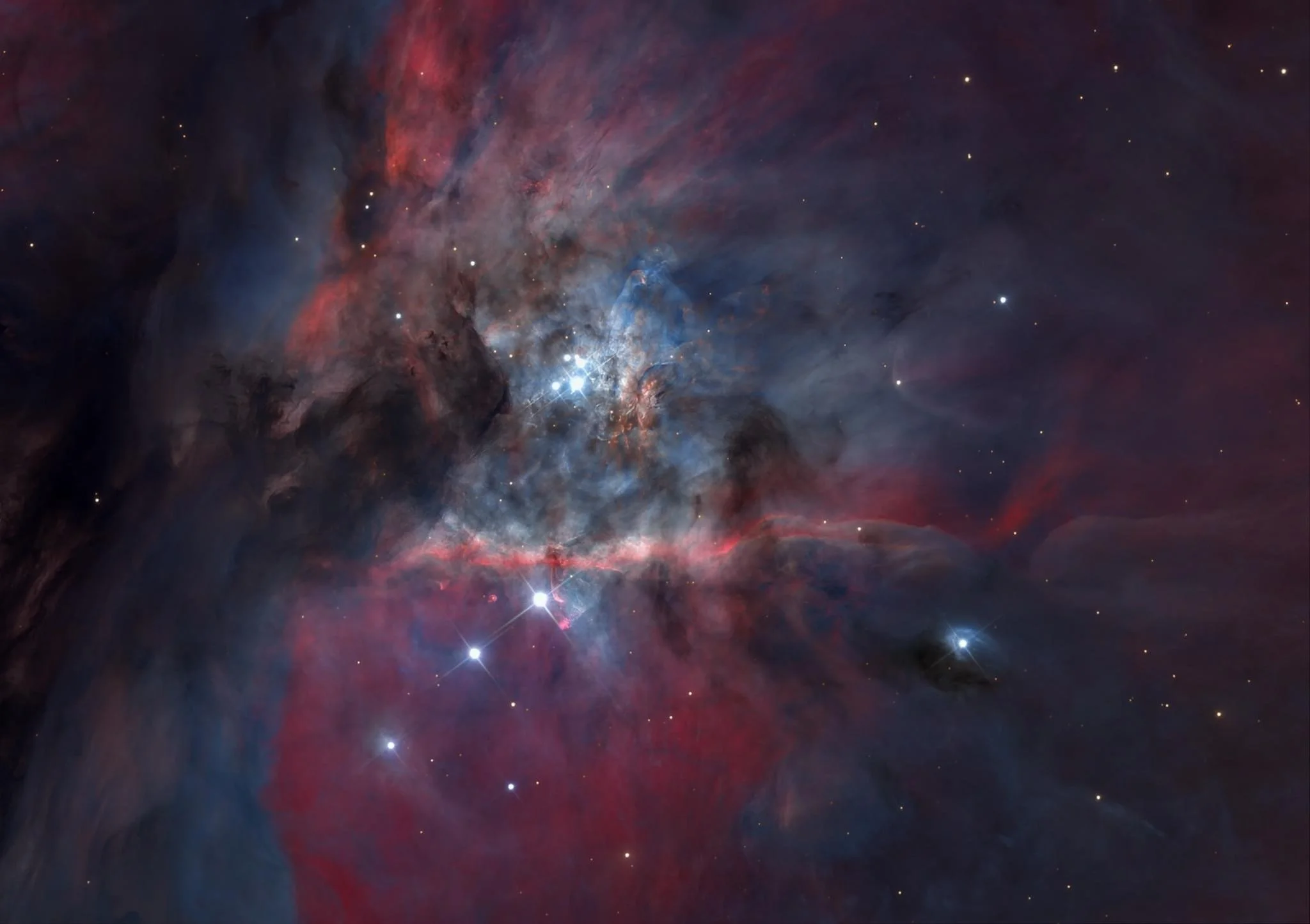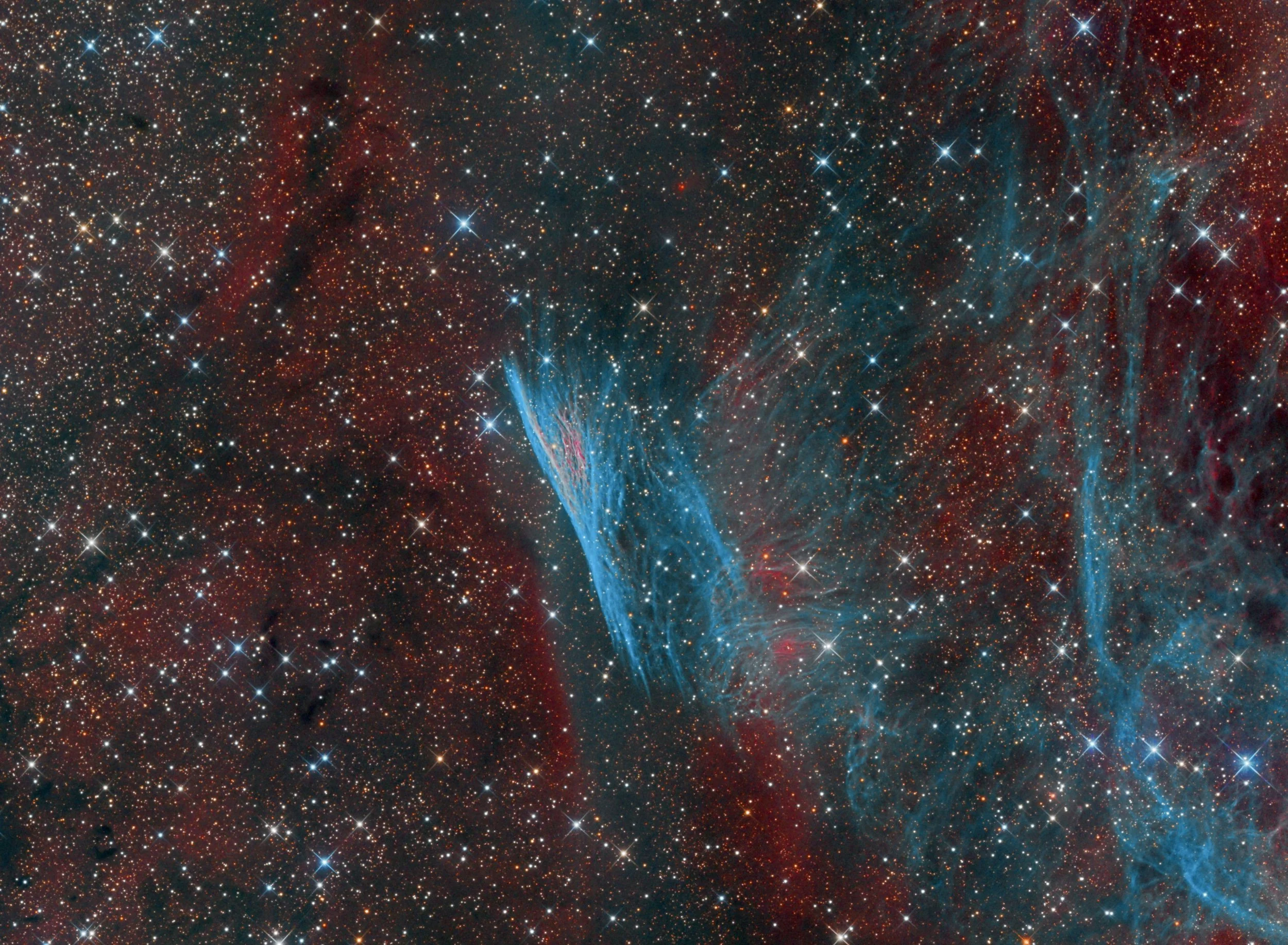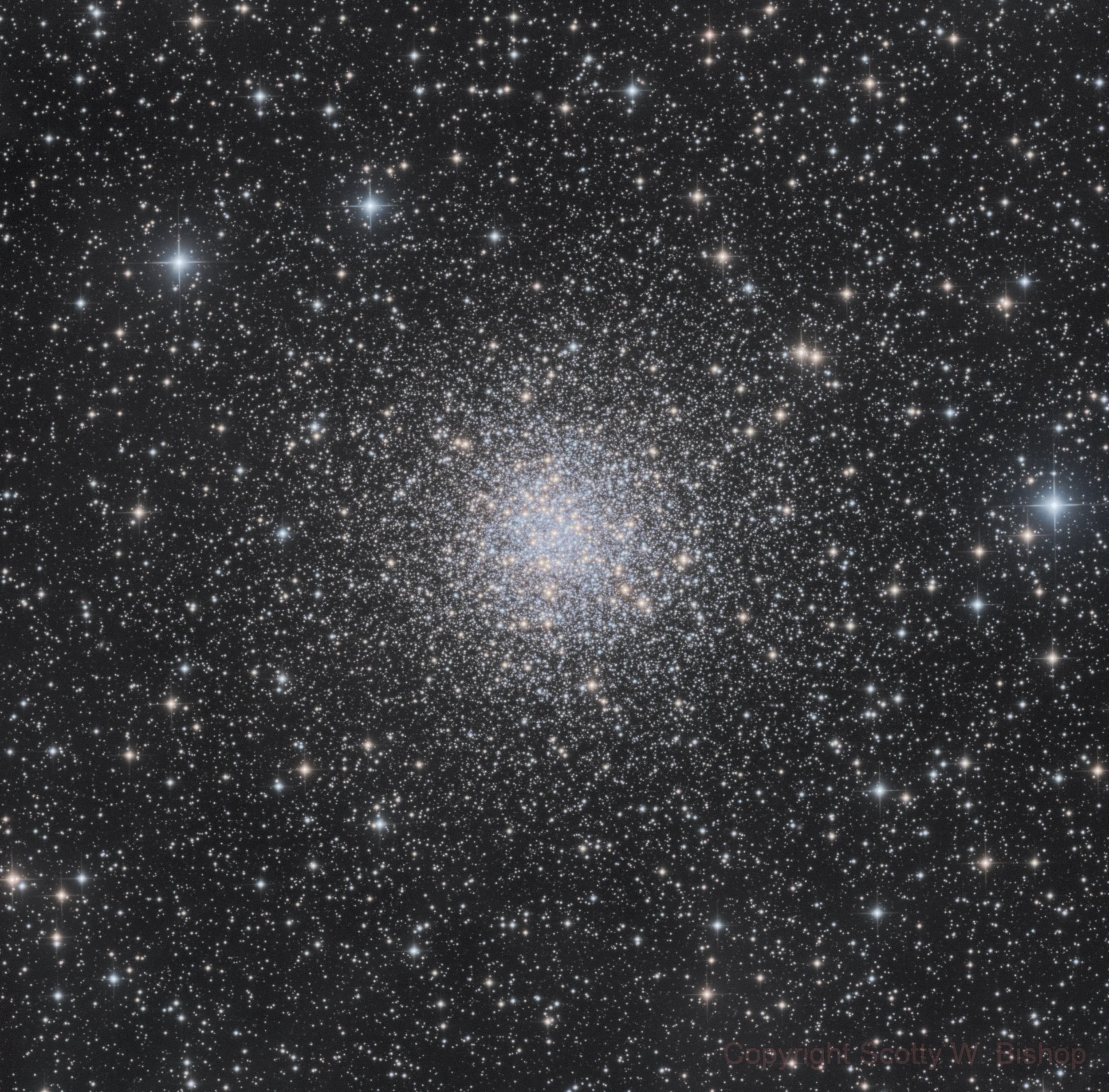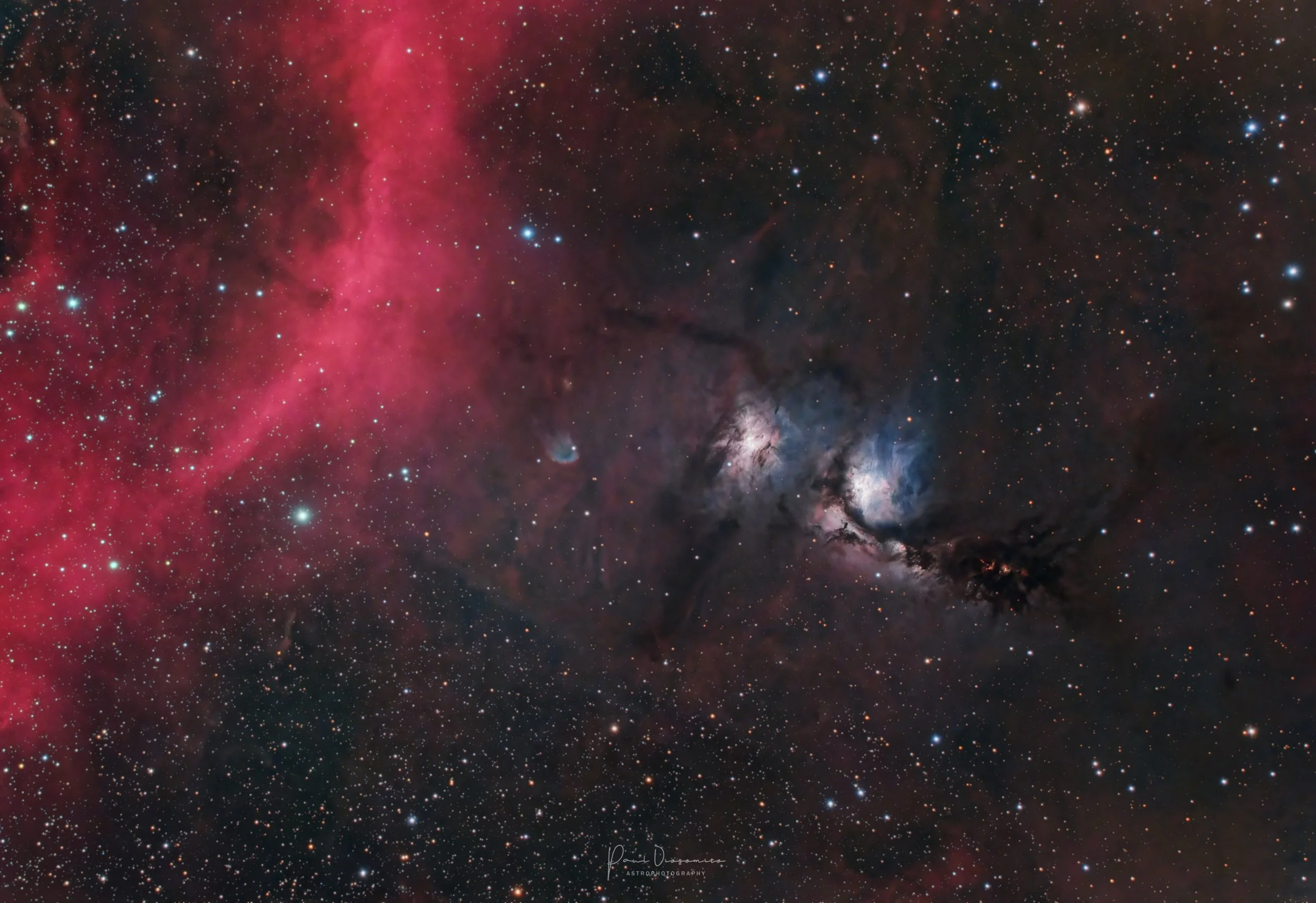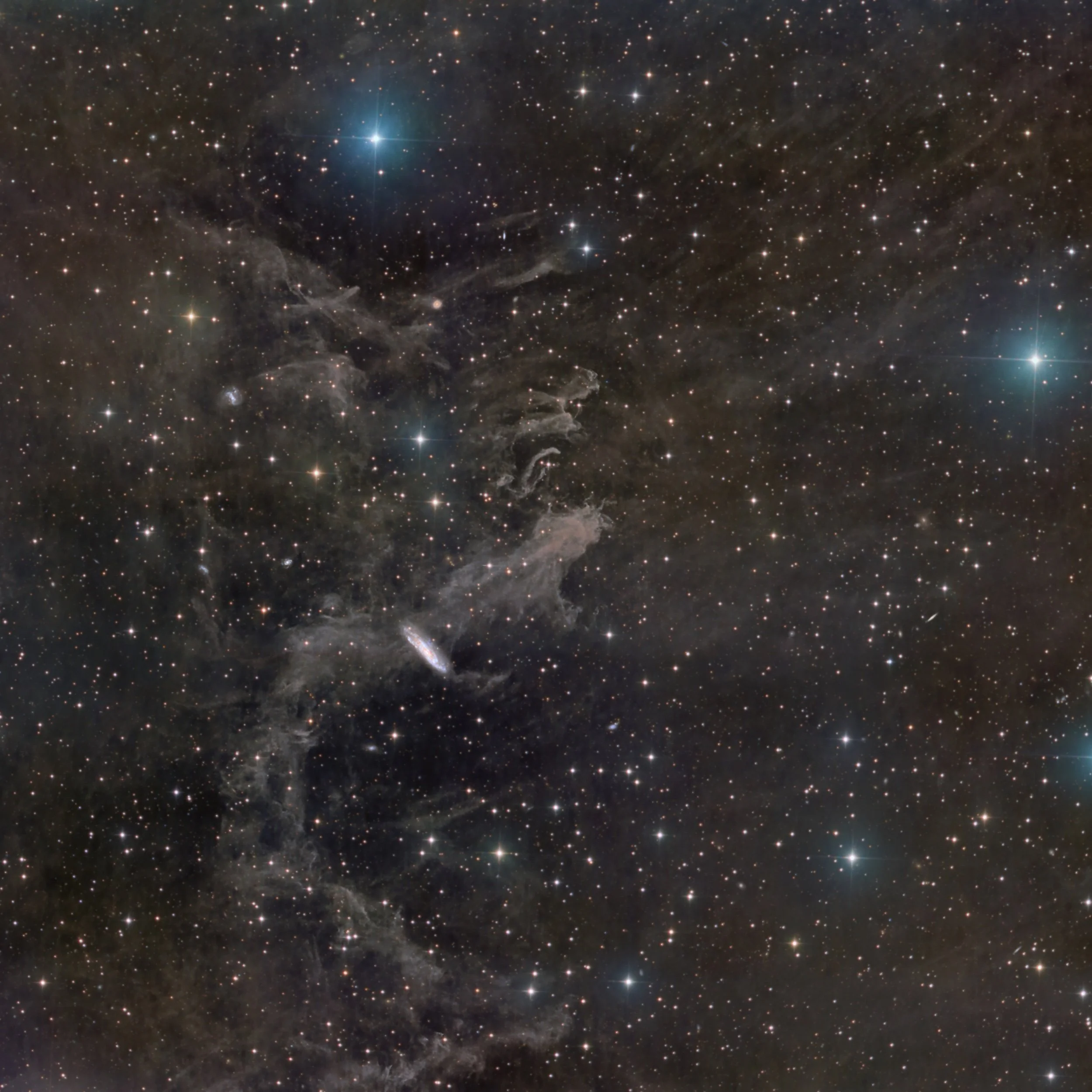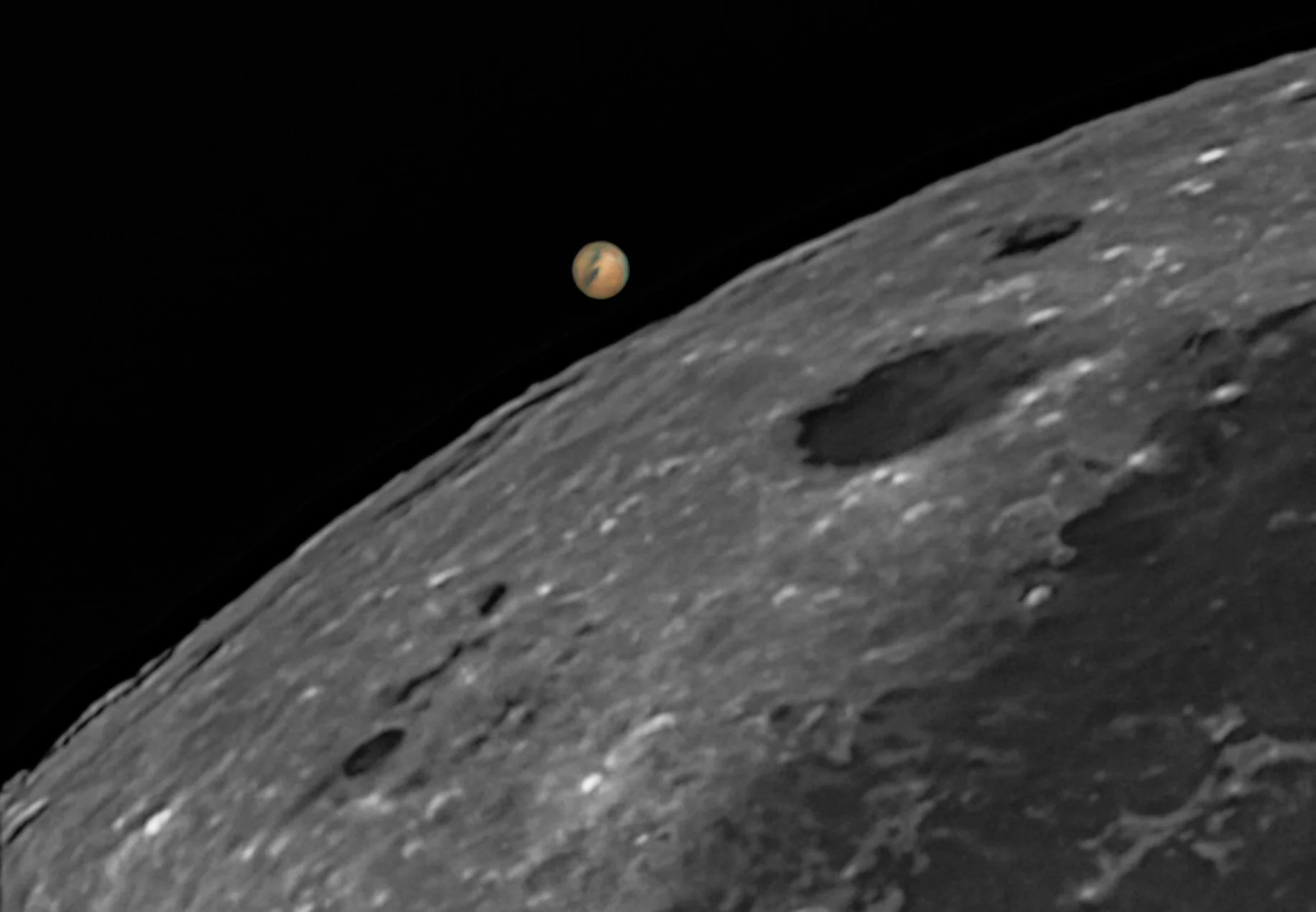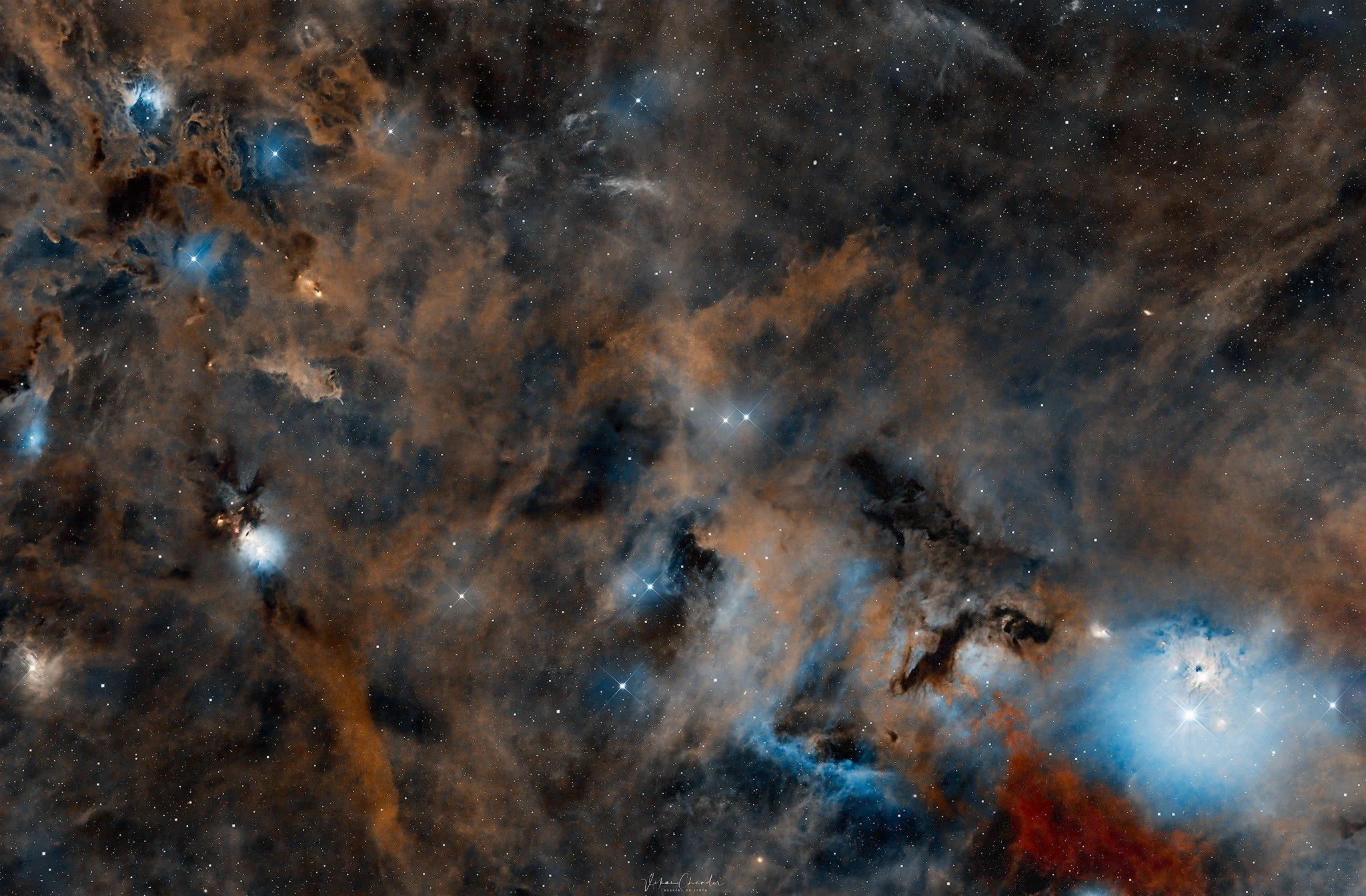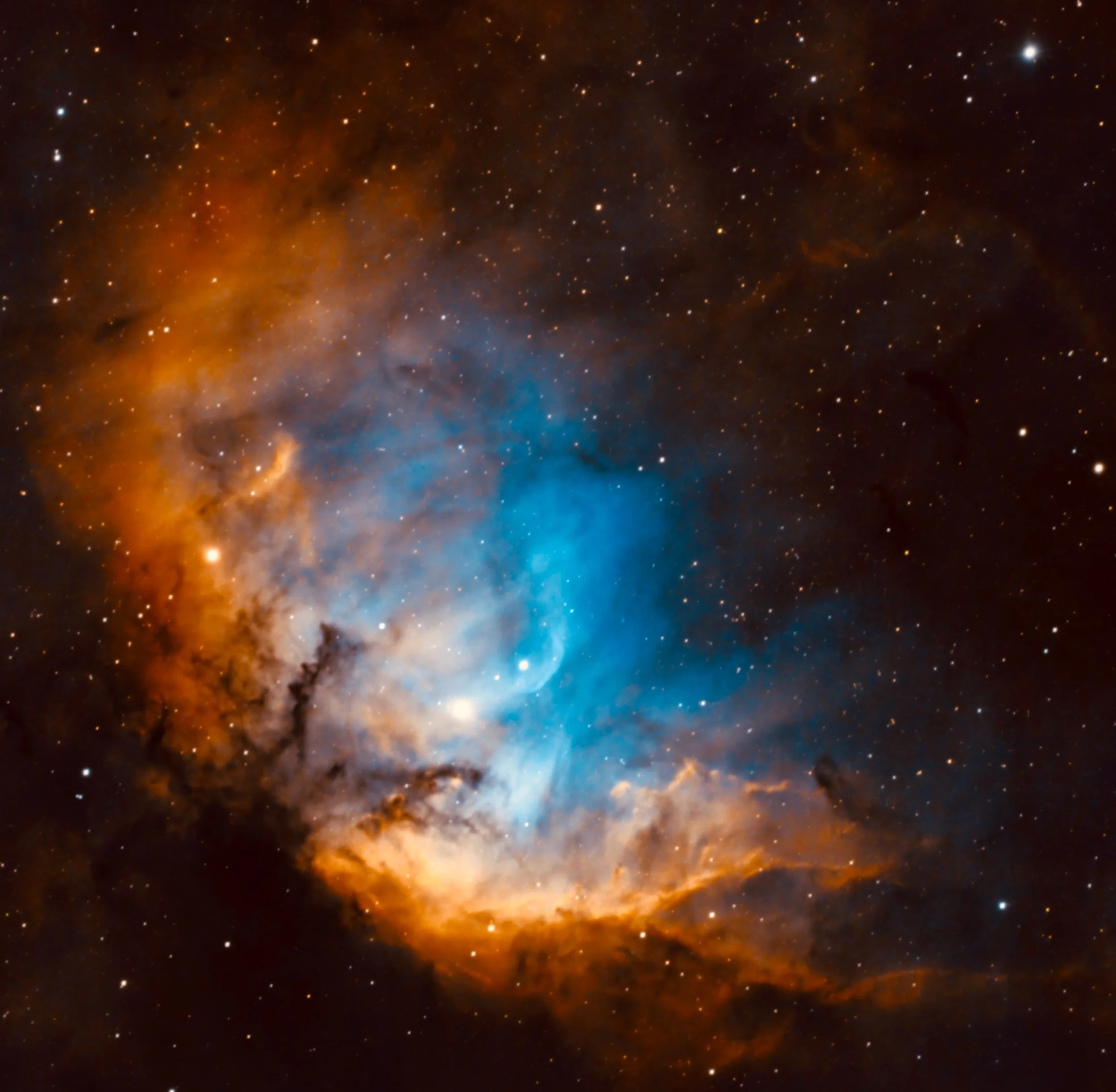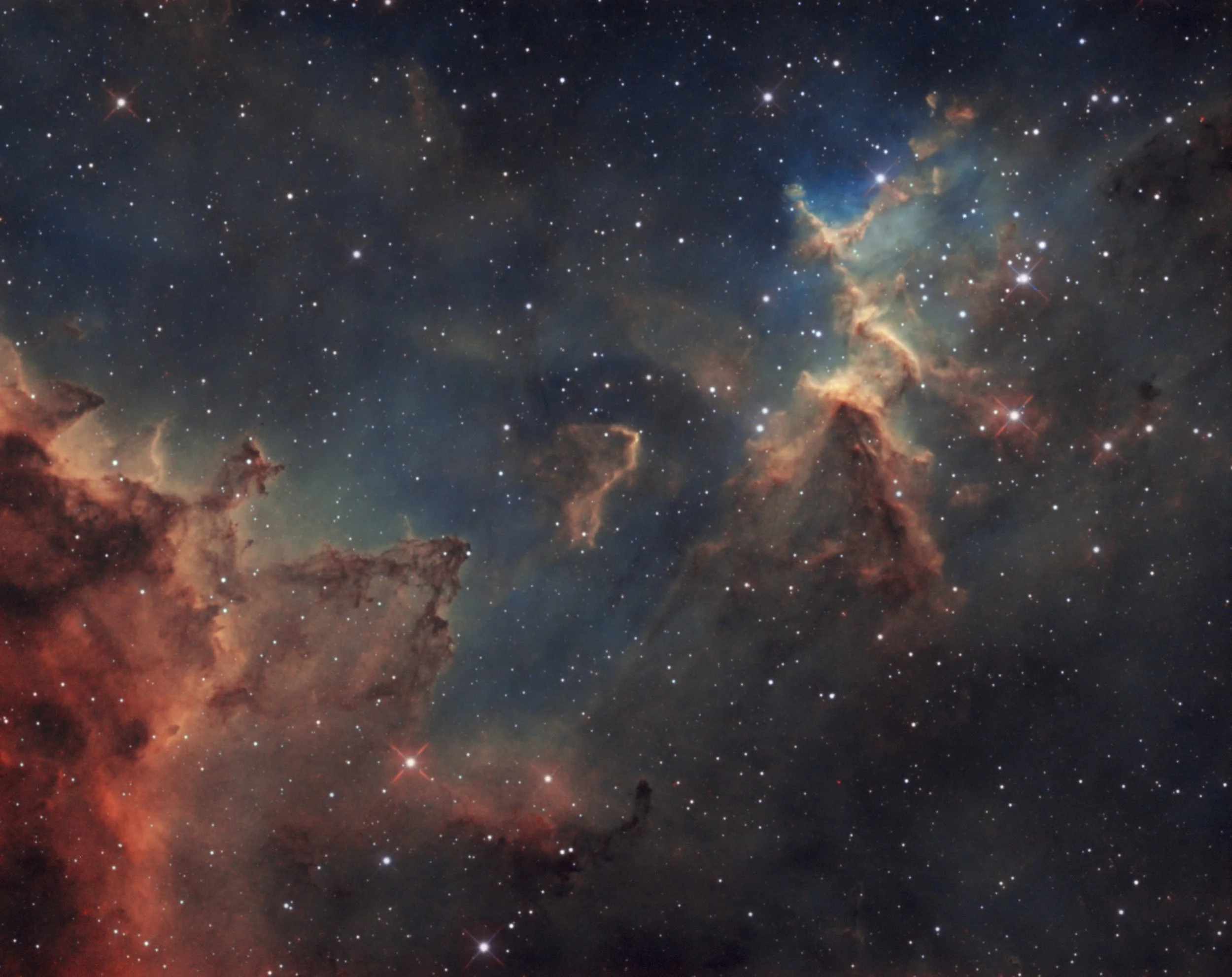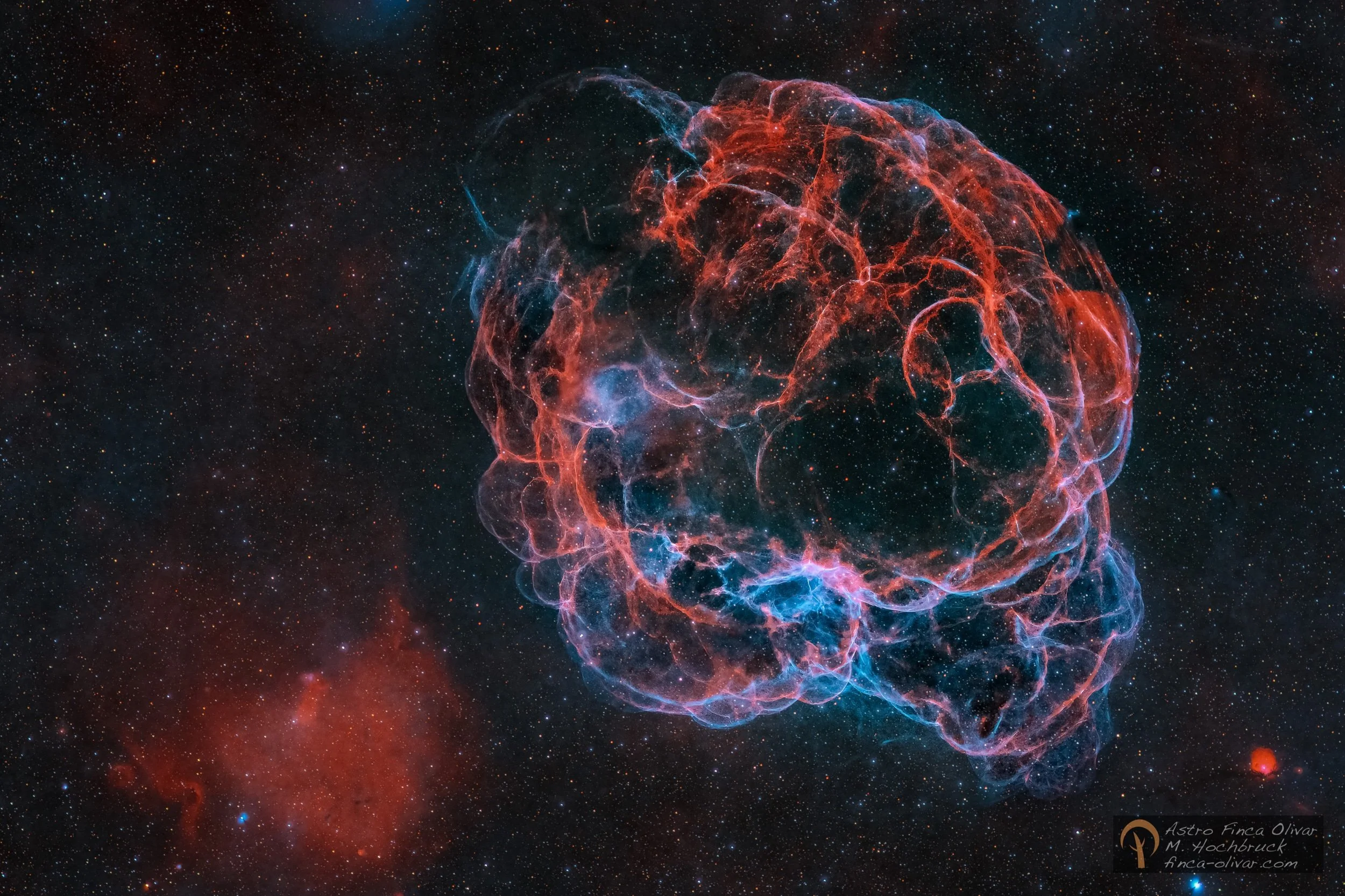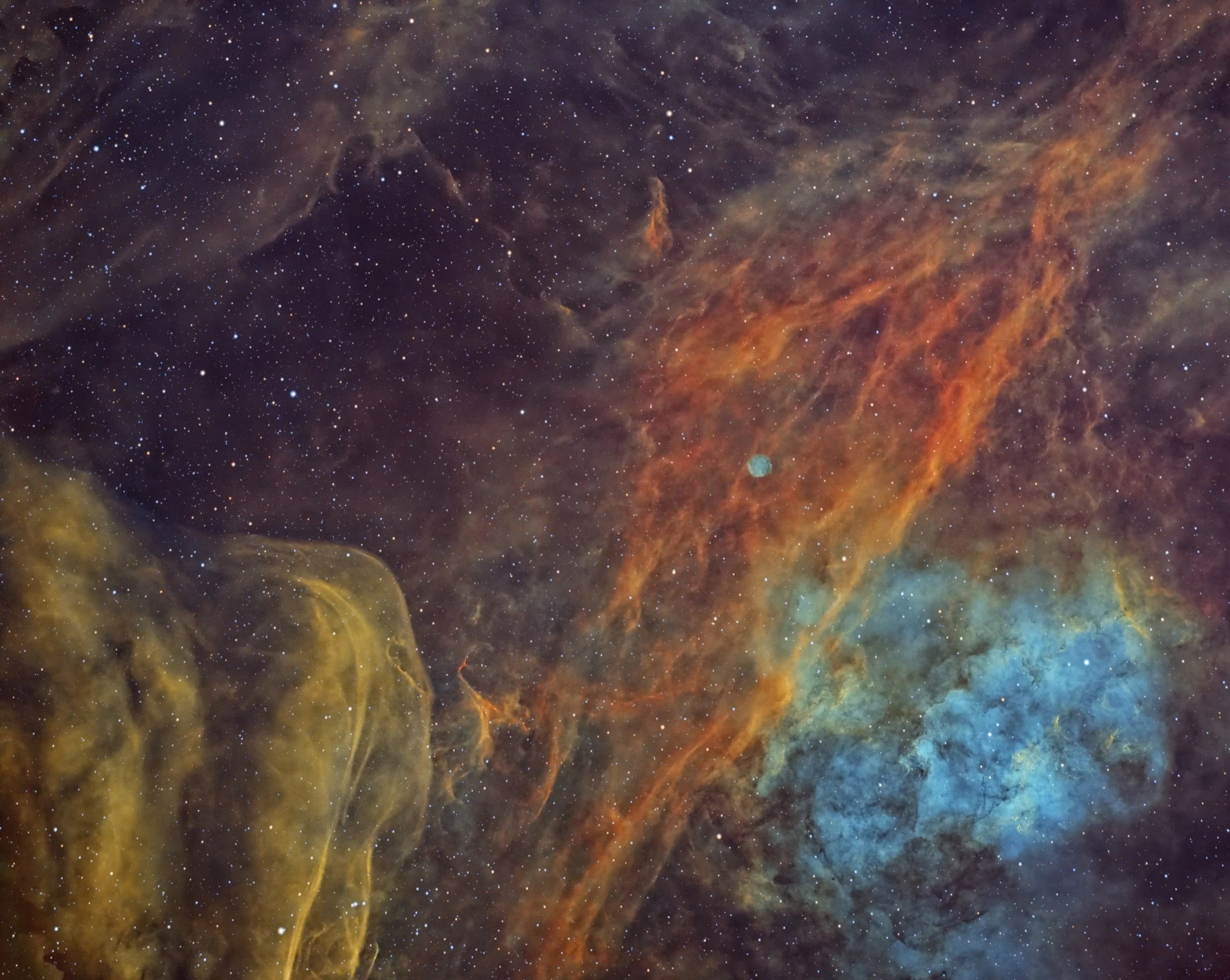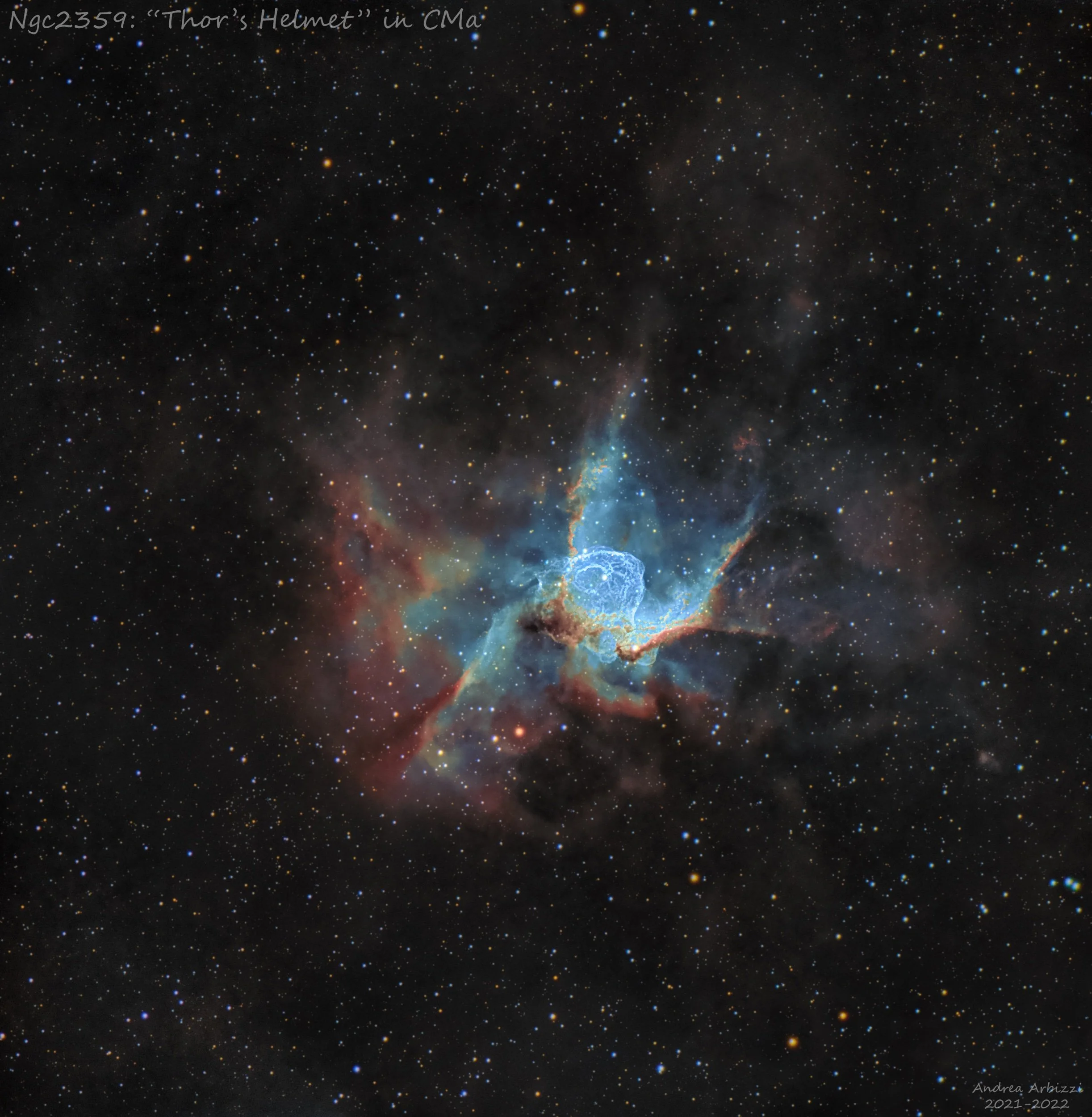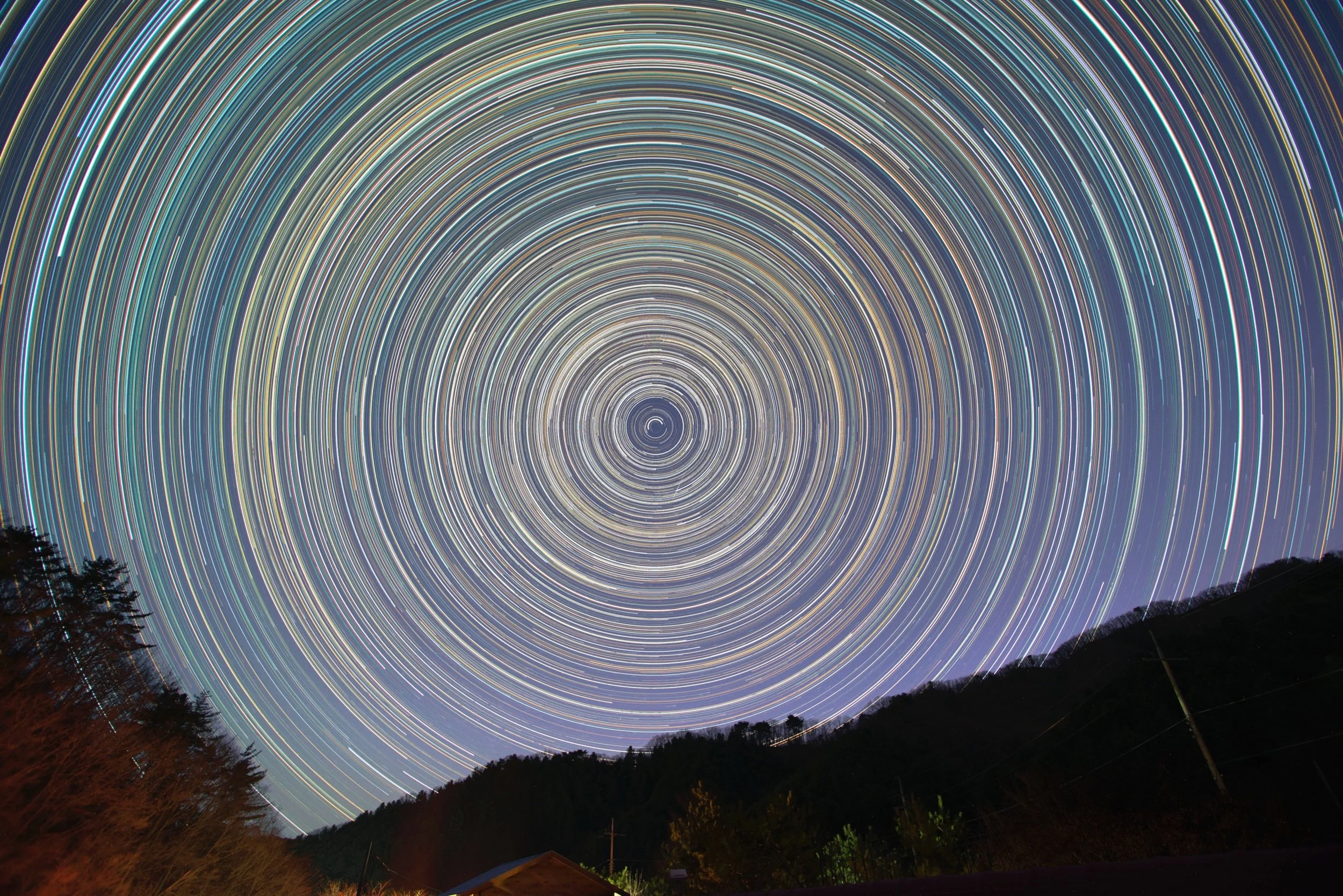
AAPOD2 Image Archives
The trapezium
I had that RGB stack of short exposures 20x30 sec. each filter for a while now and didn´t really know what to do with it.
The fwhm on the combinded image is 0.75" so it was a real magic night.
I croped the field and rotated it by 45 degrees to have the hydrogen bar horizontal.
still not sure if I have done the raw data justice, but even the small field has a dreadful dynamic range and was quite difficult to process.
Copyright: Wolfgang Promper
NGC 2736 - Pencil nebula
Image Description and Details : NGC 2736 is the brightest part of the Vela supernova remnant.
The image was taken with an ASA 12" newtonian at Tivoli astrofarm, Namibia, camera: ASI 6200MM. The image is a combination of a RGB and a narrowband image. Exposure time: RGB: 15 / 18 / 11 x 120s, Ha 8 x 500s, OIII 8x500s. Image processing was done with Pixinsight.
Copyright: Juergen Stein
NGC 7789 Carolines Rose
NGC 7789 with the collected Ha data,when I decided on this object, I suspected that there would have to be dust and ha there in the end of our Milky Way.Continuing to expose NGC 7789 in the following clear nights was the right decision.At that time, the moon appeared in the second half of the night. So I switched to the Ha filter and realized that it is really like that, Ha is quite present in the area of Cassiopeia.Caroline's rose includes many red giants, so this beautiful star cluster appears in the warm orange-red light. The additional Ha radiant in red makes this very old open star cluster even more impressive.Such star fields with all the differently shining stars fascinate me every time anew.
Integration 15h
Telescope: Takahashi FSQ 85
Camera: ZWO ASI 2600 mm
Baader Filter: 75x 300" Ha 6,5 Nm, 55x300" Lum, 35x120" RGB each
Mount: EQ6Rpro
GuidingScope:
GuidingCamera: ZWO ASI 120 mm
Copyright: Stefan "Harry" Thrun
NGC 253
Image Description and Details : First light image with my new CDK17 located at Obstech in Chile. 16 hours of LRGB data equally split between the 4 channels. Deconvolution done in CCDStack. Seeing was excellent with the Luminance master coming in at 1.35" FWHM
Copyright: Kevin Morefield
Ngc1808
NGC 1808 is a barred spiral galaxy located 40 million light years from Earth in the constellation of Columba.
While most spiral galaxies are flat disks this one has spumes of dust and gas on its outer spiral arms. The unusual shape may have been caused by a proximate encounter with another galaxy (NGC 1792). This is supported by the amount of gas moving towards the nucleus of NGC 1808 which has triggered a very high level of new star formation. The galaxy is classified as a starburst galaxy, but the heavy amount of gas and dust tends to obscure the starburst regions in ground based images. Of interest in this deep image is the resolution of the faint outer arms and star streams.
Imaged in LRGB on our CDK 1000 at Observatorio El Sauce, Obstech, Chile.
Deconvolved with RC Astro Blurxterminator Beta version.
Image Processing: Mike Selby and Mark Hanson
M78
Image Description and Details : M78(Messier 78)
Object type: Reflection nebula
Distance: 1,350 ly
Radius: 5 ly
Magnitude: +8.3
Constellation: Orion
It’s one of the most beautiful reflection nebula I’ve ever imaged due to its morphological complexity and comet like blue reflection. Its proximity to Barnard’s loop made of bright Ha emission makes this target a popular wide frame image as well. Also refers as “Casper the Friendly Ghost” of the heavens. M78 is a stellar nursery of young hot blue stars reflecting off the surrounding dust clouds. 17 Herbig-Haro objects are identified within this nebula. HH are narrow jet steams associated with new born stars that collide with nearby clouds of gas and dust.
SCT 8”, Hyperstar v4, ZWO(ASI294MC Pro, ASIAIR Pro, ASI290mm, EAF) | Sky-Watcher EQ6R Pro | 60mm Svbony guide
193X120” | IDAS LPS D3
Gain: 100, -10 °C
APP, PS(Camera Raw + Plug-ins)
10/27-28/2022
Bortle 5 Ca, USA
Copyright: Paul Diosomito
Full Oppoltation (opposition + occultation)
Image Description and Details : Amazing event: full Moon, occultation, Mars opposition in one shot
C11HD EDGE F/10
Asi183mm asi290mc
Composition of 4 images
Copyright: Alessandro Ravagnin
Dust in Perseus
Image Description and Details : Dust of Perseus
Lying a thousand light years away, in the constellation of Perseus, lies NGC 1333. It is a reflection nebula which basically is a region of dust and gases which are reflected back from the light of a nearby star. It is a region of beautiful chaos arising out of a dense group of stars being born. Dusty regions intrigue me a lot and I am very fascinated by seeing some brilliant images on various platforms of the dusty regions in Taurus and Perseus. They are best brought out with widefield mosaics with long exposures and a deft hand at post processing. A fast scope such as the E180 married to a modern sensor is best suited for the job.
Telescope: Takahashi Epsilon 180 F/2.8 Astrograph
Camera: ZWO ASI 2400MC Pro Colour CMOS 35mm Sensor
Mount: Software Bisque Paramount MX
Observatory : Roboscopes, Spain.
RGB OSC = 60 frames x 300secs x 4 panels
Total integration = 20hrs
Software = PixInsight
Copyright: vikas chander
Tarantula Nebula - NGC 2070
Image Description and Details : Tarantula Nebula, NGC 2070
One of the most amazing things in the entire sky - and only seen from the Southern Hemisphere - the Tarantula Nebula NGC 2070 in the Large Magellan Cloud is so large and bright that if it were as close as the Orion Nebula, it was cast shadows at night!
This is a SHO blend with RGB stars, taken over 12 nights through Oct-Nov 2022
Copyright: Christopher Boyd
SH2-101 - The Tulip Nebula
Image Description and Details : SH2-101 - The Tulip Nebula. Located 6,000 light years away in the constellation Cygnus.
Celestron 11” Edge HD with .7x reducer at F/7
Celestron OAG and a ZWO 174mm guide camera
Ioptron CEM 70 mount
ZWO 2600MM Pro cooled to -10° / gain 100.
ZWO ASIAIR pro+
ZWO EAF focuser
Chroma 3nm filters with ZWO 7x36mm EFW
Processed in Pixinsight.
Shot from my backyard, bortle 8.
Ha - 5 min subs x 64= 5.33 hrs.
Oiii - 5 min subs x 61 = 5.08 hrs.
Sii - 5 min subs x 63 = 5.25 hrs
Total integration time = 15.66 hrs.
Copyright: Richard McInnis
Planet Mars
Image Description and Details : Image of the planet Mars in wich we can observe Syrtis Major (on the left side), Syrtis Minor, Isidis Planitia and Gomer Sinus. On the top of Mars we can see the Planum Boreum. Images was captured through a 255mm f20 Maksutov Rumak telescope at f32 (Barlow lens) + Zwo ASI 224MC Cmos color camera and UV-IR Blocking filter.
Copyright: Francesco Badalotti
Spaghetti SH2-240 in HOO
Image Description and Details : HOO combination of 310 x 300s exposures
NIKON 180mm f 2.8 - ASI 2600MM - Antlia 3nm - AsiAir
Taken at beautiful Astro Finca Olivar - Gaucin / Andalucia
Copyright: M. Hochbruck
SH2-115 and SH2-116
Image Description and Details : SH2-115 is a faint emission nebula located in Cygnus, close to Deneb, the brightest star of that constellation.
SH2-116 or Abell 71 is the designation of the small round patch of emission nebulosity in the center, it is a small patch of emission nebula.
Imaged in Bortle 6 skies in Washington DC suburbs in my backyard.
Scope: Astro-Physics Stowaway 92mm f/5.3
Imaging Cameras: ZWO ASI2600MM Pro
Mounts: iOptron CEM40
Filters: Chroma 3nm SHO
Software: Adobe Photoshop, Pleiades Astrophoto PixInsight, Tria
Copyright: gmadkat
Ngc2359: "Thor's helmet" nebula
Image Description and Details : NGC 2359 (also known as Thor's Helmet) is an emission nebula in the constellation Canis Major. The nebula is approximately 30 light-years in size. The central star is the Wolf-Rayet star WR7, an extremely hot star thought to be in a brief pre-supernova stage of evolution. It is similar in nature to the Bubble Nebula, but interactions with a nearby large molecular cloud are thought to have contributed to the more complex shape and curved bow-shock structure of Thor's Helmet.
The nebula has an overall bubble shape, but with complex filamentary structures.
APM Apo 140 F4,6 (646 mm) + Tecnosky Apo 125 f5,1 (640 mm)
ZWO ASI533MC Pro
iOptron GEM45 + iOptron CEM40
November 2022
Optolong L-Ultimate (3 nm): 62X600"
Optolong Uv Ir cut: 40X30” (star color)
November 2021
Optolong L-eXtreme: 87X600"
Tot: 25h 10'
Modena (Bortle 8), Italy
Copyright: Andrea Arbizzi
North Sky Star trail
Image Description and Details : Nikon D800
Tamron SP AF 17-35mm F/2.4 (25mm, F/4)
ISO 200, 1min x 692
Manfrotto 055D
Copyright: Kim Young Dae
Bubbling Rose
Image Description and Details : After a few months off while i had planetary equipment on the mount. The RC is now back on the mount for some deep sky imaging again. Starting with the Bubble nebula or NGC 7635. 8000 light years away in the constellation Cassiopeia. Captured from my Bortle 5 backgarden in west sussex over many nights. I also added the data i captured back in 2021, as it's a target i find fascinating and keep returning to. Capture details:118x 600 Ha. 63x 600 oiii and 58x 600 sii.Equipment details: EQ6-rASI 1600mmBaader 1.25" narrowband filtersOrion RC 8"
Copyright: Carl Gough
Messier 78 - Casper the Friendly Ghost
Image Description and Details :
Shot in true color (with Ha added) in Borrego Springs earlier this month at the Nightfall star party, this is one I have attempted several times at home and it's never really worked out. It needs a dark sky. Casper is a rather famous reflection nebula in Orion not far from the Horsehead and the Great Orion Nebula. About 1,500 light years distant, Casper is a dynamic star-forming region containing about 45 T Tauri stars (young stars that are still forming) and 17 Herbig-Haro (HH) objects (objects that are not quite stars but presumably will be soon). Several of the HH objects are visible in the image as bright red dots surrounded by cold, dark dust.Details: Celestron EdgeHD 1100 telescope with 0.7x reducer; 10Micron GM1000HPS mount; ZWO ASI6200MM camera; Chroma LRGB filters and Chroma 3nm Ha filter for the hydrogen-alpha signal); 9 hours exposure time.
Copyright: Copyright © 2022 by the Accidental Astronomers

